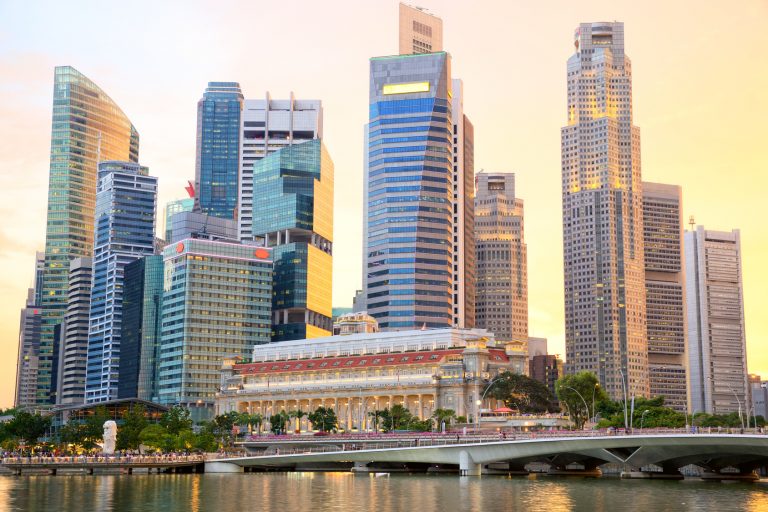Singapore Spurs Development of FX Trading Hub & Ecosystem
June 11, 2019 | By: Ivy Schmerken

By Ivy Schmerken
With the uptick in Asian currency trading and the growth of electronic trading, Singapore’s regulator is working with the financial industry to build an FX trading hub and expand FX market infrastructure, a move to improve liquidity and price discovery during Asian trading hours.
The Monetary Authority of Singapore (MAS) is offering financial incentives to major banks and non-bank liquidity providers that agree to build matching engines and pricing engines in the country, reported Bloomberg on April 24 in “Shaving Milliseconds Off Currency Trades Could Make Singapore Billions.” The regulator has consulted with major forex players, encouraging them to build systems in the Southeast Asian nation to reduce the latency caused by routing trades to Tokyo or London.
On June 3, Standard Chartered Bank announced plans to establish an FX trading engine and pricing engine in Singapore with support from MAS. The bank plans to launch the new e-trading engine by the first quarter of 2020, offering clients FX e-trading in 130 currencies and more than 5,000 currency pairs in spot, forward, swaps, non-deliverable forwards and options, as well as commodities e-trading for both precious and base metals.

“The move is aligned with our goal of enhancing liquidity, price discovery and transparency in Singapore’s FX market by strengthening FX e-trading capabilities and market infrastructure,” stated Gillian Tan, Executive Director, Financial Markets Development Department, MAS in the bank’s release. UBS Group and Citigroup have already set up matching and pricing engines and MAS aims to get six to eight more players including major banks and multi-dealer platforms, reported Bloomberg.
Non-bank liquidity providers, which demand low latency, are also key to the strategy. XTX Markets, an electronic non-bank liquidity provider, was the first to build a matching engine and pricing engine in Singapore.
“If you are seeing more and more trading in Singapore, it would make sense to have that proximity especially for an electronic market-maker/liquidity provider,” said Brad Bailey, Capital Markets Research Director at Celent. “You need to have part of your infrastructure in a situation like that, so you can trade rapidly and quote rapidly,” said Bailey.
Regulatory Incentives

The government incentives are part of a strategic plan to develop Singapore into a major ecosystem for trading major currencies as well as emerging market products such as the Chinese Yuan. One of the goals under the regulator’s “industry transformation map” or ITM, is to develop Singapore into a global price discovery and forex liquidity center in the Asian time zone.
“Singapore has now become the third largest financial center in FX trading activity with a significant increase in volume from buy-side institutions like hedge funds, asset managers, and insurance houses ,” said Vinay Trivedi, Senior Vice President, Strategic Initiatives & Head of FX Sales, APAC at FlexTrade Systems. With Asian investment flows expected to increase, the region has attracted many new forex players. Sophisticated electronic traders acting as liquidity providers (LPs) have put their servers in data centers.

“As Asia’s FX trading needs grow, and as electronification of Asian FX trading progresses, there is a need for a more efficient price discovery venue where pricing and matching of trades takes place,” stated Jacqueline Loh, Deputy Managing Director, Monetary Authority of Singapore in a May 2018 speech reported in FX Week.
Evolution of FX Market
The move could also help Singapore capture a bigger bite of the $5.1 billion-a-day global foreign exchange market.
Singapore is already Asia’s largest forex trading center by volume ahead of Hong Kong and Japan. But Singapore, with $517 billion a day, ranks third globally behind the UK with $2.41 trillion and New York with $1.27 trillion each day, according to the 2016 Triennial Survey by the Bank of International Settlements (BIS). The survey showed there was a major uptick in Asian currency trading. [The BIS is conducting a new triennial survey with the results due in September.]

On May 6 Equinix, which operates major FX trading hubs around the world, held an event with MAS in Singapore with several of the large trading venues and banks attending. “I think there is high enthusiasm to build out the trading hub,” said John Knuff, VP Financial Technology, Ecosystem Development.
A number of factors are attracting firms to Singapore, such as the positive business climate, the regulator’s grants and tax incentives as well as the nation’s reputation for upholding the rule of law, said Knuff.
Equinix had approached the government on the creation of an OTC and FX hub several years ago. Several clients from London, New York and Tokyo asked about new asset classes and instruments that would be a good fit for Singapore.
Reducing Latency
But it remains to be seen if volumes and FX liquidity will shift to Singapore.

“If you look at the FX market, it’s very much low latency. It’s based around key data centers in New York, London and Tokyo. It’s not the easiest thing in the world to move these natural places where these data centers are set up,” said Bailey.
The challenge is that orders created in Singapore must be routed to FX matching platforms sitting in Tokyo or London. Currently, the three main data centers —NY4, LD4 and TY3 — all operated by Equinix, serve as FX trading hubs in New York, London, and Tokyo.
Roundtrip latency between Singapore and Tokyo is about 70-80 milliseconds, said FlexTrade’s Trivedi.
If the matching engine and pricing is located in Tokyo, then the quote will take 35-40 milliseconds to go from Tokyo to Singapore. If the client takes the quote immediately, then sends an order from Singapore to Tokyo, it takes another 35 to 40 milliseconds, which is why the roundtrip latency is 70-80 milliseconds, explained Trivedi. If a firm sends the same order to New York, it takes 200 to 220 milliseconds. If the matching were occurring in SG1 in Singapore the latency would be negligible, he said.
Some active market makers have started to update quotes every 5-10 milliseconds, said Trivedi. But the geographical latency results in either higher rejections or unwarranted risk to market makers, said Trivedi. This invariably results in wider spreads for the client, which also makes the market maker non-competitive. Thus, running a market maker’s pricing out of SG1 will provide a competitive edge, he said.
Banks and brokers have located their pricing engines in Tokyo (TY3) to be close to FX trading platforms like CME Group’s recently acquired EBS, and their own sales teams sitting in Singapore. While the majority of international banks have their Asian sales and trading teams in Singapore, the matching is still happening in Tokyo’s TY3 data center mainly due to EBS’s moving to TY3 earlier in the decade.
Similarly, institutional B-broker-dealers also have active sales and trading desks in Singapore and Hong Kong, said Trivedi. “It was kind of ironic that the volume is originating in Singapore, but the matching is happening in Tokyo,” he said.
“If that is where the volume is generated then why not push market makers or interbank traders and clients to create an ecosystem to have matching in Singapore?” said Trivedi.
To close the latency gap, MAS is trying to persuade banks and high-speed electronic market makers to build their matching engines in Singapore, which will shave tens of milliseconds off the latency.
“You can actually come down to sub-millisecond latency if your traders can have a matching engine in Singapore,” said Trivedi.
“The matching should happen in Singapore, not in Tokyo, for the flow which is coming out of Singapore,” he added.
Citi will expand its longstanding FX hub in Singapore which includes a proprietary pricing and hedging algorithm, through which clients can deal, noted its March 11 release.
“The expansion of our FX trading engine will also lead to a vast improvement in latency for our clients in Singapore and across much of Asia Pacific, who prior to this would connect via Tokyo or one of our trading engines outside of the region,” stated Stuart Staley, Asia Pacific Head of Markets and Securities Services at Citi in its release. “With Asia Pacific expected to attract a larger share of global investment flows, this initiative will improve price transparency and facilitate more efficient price discovery in the region’s time zone,” added Staley. But the latency factor is not necessarily what’s prompting firms to build matching and pricing engines in Singapore.
Equinix’s Knuff said the origination of trading and the number of trading desks in Singapore is what’s driving the number of exchanges and matching engines into Singapore.
“What will gain first mover business and what will start to gain share is real liquidity with certain [currency] pairs having high trading volume. I think that is driven by the origination of trades in Singapore,” said Knuff. “Going back to when there was a singular market in London transitioning to New York and then transitioning to Tokyo, that was largely driven by following the sun,” he said.
“Now that there is electronic trading, it’s more the liquidity and the amount of trading generated by Singapore-based trading desks driving the deployments, “he said. “It’s more about risk factors — traders want to know the price they see on the screen can be executed. That’s best done if it’s done locally,” he said.
Michele Wee, Head of Financial Markets Singapore at Standard Chartered Bank, stated that through the bank’s new e-trading platform in Singapore, “clients in Asia can enjoy enhanced FX trading efficiency and improved liquidity. We also can offer them a more seamless experience and consistent pricing to meet their hedging requirements.” In addition, the bank has seen a 40% year-on-year growth in FX-e trading volumes in Singapore, noted Wee.
Massive Exercise
However, setting up a matching engine is a massive cost exercise and moving liquidity is not easy. “It takes a few years before a new matching engine becomes successful,” said Trivedi. There should be a reason for adding another matching engine; otherwise, there is a risk of fragmenting the order flow between Tokyo and Singapore.
That is why MAS is running an incentives program. So far MAS has attracted a strong pipeline of players, including global tier 1 banks, non-banks and platforms to better support their clients during Asian trading hours. First, it targeted top market makers about setting up matching engines and pricing engines and offered to fund their software costs. Second, they reached out to platforms like EBS about setting up a matching engine in Singapore as the primary market. Third, they approached ECNs and multi-dealer trading platforms, as well as FX aggregators. For example, FastMatch, now owned by Euronext, has set up a token server and is now in the running to get MAS grants under the ECN/multi-dealer category.
UBS became the first bank to install their pricing engine in Singapore. “They saw immediate results as they were able to connect with the FlexTrade matching engine in SG1 used by a top tier local bank, said Trivedi. The other top-tier local banks are also planning to follow suit.
Likewise, XTX, a top-tier non-bank market-maker also went live with one of the biggest hedge funds in Asia, as well as with a top-tier local bank in SG1.
It means right from quote generation to order matching, everything is happening on FlexTrade’s matching engine hosted in Singapore. “This has resulted in sub-millisecond matching with almost a 100% fill ratio, with positive feedback from clients and market makers,” said Trivedi.
Knuff expects additional exchanges that operate FX trading platforms to deploy in Singapore that have not been announced. Non-bank liquidity providers are using automated trading systems to make markets in the offshore Chinese Yuan on the Singapore Exchange. Jump Trading and XTX Markets are boosting volumes in the offshore yuan market as well as Asian non-deliverable forwards, reported Bloomberg in “Yuan Trading Finally Goes Global as Bots Displace Voice Market.”
SGX Futures & Offshore Yuan Trading
SGX’s main futures contract is the renminbi (CNH),which is the offshore Chinese Yuan market.
Trading in USD/CNH futures on the Singapore Exchange (SGX) achieved a record US$194 billion in 1Q 2019, up 122 per cent year-on-year from US$87 billion, reported The Business Times on April 10.
The U.S.-China trade war has stirred up volatility in the offshore renminbi market. “The interplay of all the local currencies with the Yuan is probably getting bigger and bigger,” said Knuff.
Investors are also interested in the interdependence between FX, fixed income and OTC markets, said Knuff, adding that MAS is smart by not just paying attention to forex but looking out to a broad set of instruments.
“With the changes in NDFs, FX options and FX futures, you will see several global exchanges deploy into Singapore,” said Knuff. He pointed to the Intercontinental Exchange, which operates via the Secure Financial Transactions Network, and Asia Pacific Exchange (APEX), a Chinese-backed exchange, which launched a palm olein futures contract in May. “Singapore is well positioned in derivatives,” he said, adding that average daily volumes in NDFs are high. He predicts that some of the OTC derivatives markets will soon gravitate into Singapore as well.

How FlexTrade Can Help With Your FX Trading
For a complete review of your firm’s FX trading requirements and a demonstration of FlexTrade’s foreign exchange solutions for the sell side and buy side, please contact us at sales@flextrade.com for further information.
Past Blog Posts Related to FX Trading Issues
Global FX Code Gains Adoption But Last Look is a Thorny Issue
Ethical FX Via the Global Code
FX Trading in Asia Pacific: Q&A with Vinay Trivedi (Part 1)
FX Trading in Asia Pacific: Q&A with Vinay Trivedi (Part 2)
Six Trends for Currency Markets
FX Volatility “Trumping” Forward into 2017
FX Algo Usage Rises as the Buy Side Takes Charge